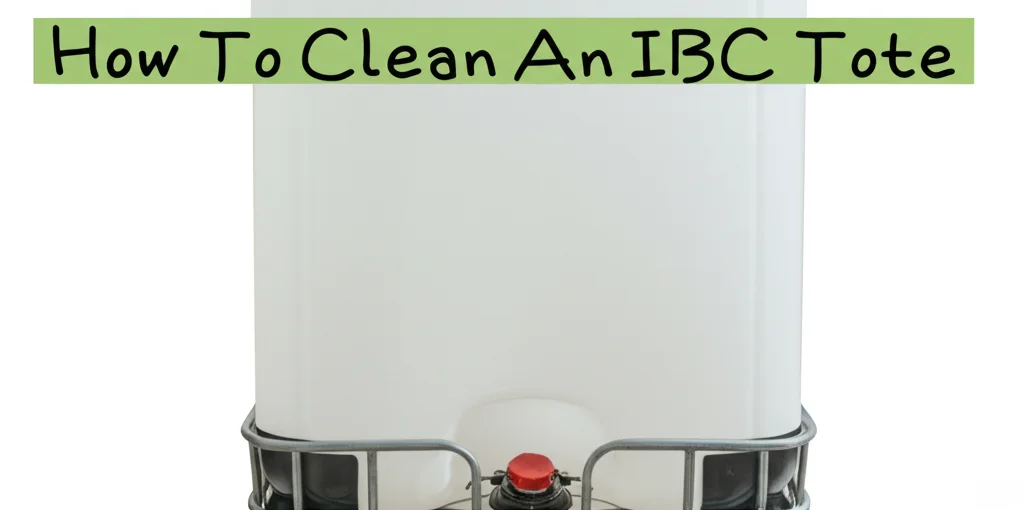· Cleaning Guides · 7 min read
How To Clean An IBC Tote

Cleaning Your IBC Tote: A Step-by-Step Guide
Have you recently emptied an IBC tote and are wondering how to get it ready for its next use? Cleaning an IBC tote (Intermediate Bulk Container) is crucial for preventing contamination and ensuring the integrity of whatever you store in it next. This guide will walk you through the process, from initial rinsing to final sanitization, making sure your tote is spotless and ready to go. We’ll cover everything you need to know to effectively clean your IBC tote, ensuring it’s safe for a variety of applications.
Takeaway:
- Thoroughly rinse the IBC tote with water to remove loose debris.
- Use a cleaning solution appropriate for the previous contents.
- Sanitize the tote to eliminate bacteria and potential contaminants.
- Rinse again to remove all traces of cleaning and sanitizing agents.
- Allow the tote to air dry completely before reuse.
Quick Answer: To clean an IBC tote, start by rinsing it with water, then use a detergent suitable for the previous contents. Scrub the interior, rinse thoroughly, sanitize with a food-grade sanitizer, and finally, let it air dry completely before refilling.
1. Assessing the Previous Contents & Initial Rinse
Before you begin, consider what was previously stored in the IBC tote. This will dictate the type of cleaning solution you’ll need. For example, a tote that held a food-grade liquid will require a food-safe cleaning process, while one that held a non-toxic industrial chemical might need a different approach. Start with a thorough rinse using a garden hose or pressure washer. This removes any loose sediment or remaining product.
Don’t underestimate the power of a good initial rinse! It’s the foundation for a successful cleaning process. If the tote held a viscous substance, you might need to use a low-pressure nozzle to avoid damaging the plastic. For more stubborn residue, consider a preliminary soak with warm water before rinsing. If you’re dealing with a particularly dirty tote, you might want to check out resources on how to clean a dumpster for inspiration on tackling tough grime.
2. Choosing the Right Cleaning Solution
Selecting the appropriate cleaning solution is vital. Avoid harsh chemicals that could damage the IBC tote’s plastic or leave behind harmful residues. For most applications, a mild detergent and warm water are sufficient. For stubborn residues, consider these options:
- Food-Grade Detergents: Ideal for totes that previously held food products.
- Industrial Degreasers: Effective for removing oils, grease, and other industrial contaminants.
- Citric Acid: A natural cleaner that’s great for removing mineral deposits and scale.
- Bleach Solution (Diluted): Use with extreme caution and only if necessary, ensuring thorough rinsing afterward.
Always follow the manufacturer’s instructions for dilution and safety precautions when using any cleaning solution. Remember, proper cleaning is essential, and sometimes you need to go the extra mile. If you’re looking for ways to keep other surfaces clean, you might find tips on how to clean aluminum helpful.
3. Scrubbing the Interior: Reaching Every Corner
Once you’ve applied the cleaning solution, it’s time to scrub the interior of the IBC tote. This is where a long-handled brush comes in handy. You’ll need to reach all surfaces, including the bottom, sides, and baffles (the internal structures that help stabilize the tote).
- Use a dedicated IBC tote brush: These are designed to fit through the opening and reach all areas.
- Focus on areas with visible residue: Pay extra attention to corners and seams where contaminants tend to accumulate.
- Consider a rotating brush head: These can provide more effective scrubbing action.
Don’t rush this step! Thorough scrubbing is essential for removing all traces of the previous contents. If you’re struggling to reach certain areas, you might consider using a pressure washer with a specialized nozzle. Maintaining clean surfaces is important, and you can find more information on keeping windows spotless with a guide on how to clean windows.
4. Rinsing Thoroughly: Removing All Traces of Cleaner
After scrubbing, rinse the IBC tote extremely thoroughly. Any remaining cleaning solution can contaminate your next batch of product. Use a high-pressure hose to ensure all surfaces are rinsed, including the baffles and the outlet valve.
- Rinse until the water runs clear: This is the best indicator that all traces of the cleaning solution have been removed.
- Inspect for residue: Visually inspect the interior for any remaining foam or discoloration.
- Repeat rinsing if necessary: Don’t hesitate to rinse multiple times to ensure complete removal.
This step is arguably the most important. Contamination can lead to significant problems, so take your time and be meticulous. Just like ensuring a clean rinse for your IBC tote, maintaining clean windows is also crucial; you can learn more about that with a guide on how to clean windows outside.
5. Sanitizing the IBC Tote: Eliminating Bacteria
Even after thorough cleaning, bacteria and other microorganisms may still be present. Sanitizing the IBC tote eliminates these potential contaminants. Common sanitizing agents include:
- Food-Grade Sanitizers: Peracetic acid, chlorine dioxide, and iodine-based sanitizers are commonly used in food processing.
- Bleach Solution (Diluted): Again, use with caution and ensure thorough rinsing.
- Hydrogen Peroxide: A milder alternative to bleach.
Follow the manufacturer’s instructions for dilution and contact time. Ensure the sanitizer comes into contact with all interior surfaces. Sanitizing is a critical step, especially if you’re storing sensitive materials. If you’re looking for ways to maintain a clean and healthy environment, you might find information on how to clean air from mold helpful.
6. Final Rinse & Air Drying: Preparing for Reuse
After sanitizing, rinse the IBC tote again to remove any traces of the sanitizing agent. This is just as important as rinsing after cleaning. Once rinsed, allow the tote to air dry completely.
- Leave the cap or bung open: This allows for proper ventilation.
- Store the tote in a well-ventilated area: This speeds up the drying process.
- Inspect for moisture before reuse: Ensure the interior is completely dry to prevent mold growth.
A completely dry IBC tote is ready for its next use. Proper drying prevents contamination and ensures the longevity of your container. Just as allowing your IBC tote to air dry is important, ensuring your carpets are thoroughly dry after cleaning is also crucial; you can find more information on how to clean commercial carpet.
7. Inspecting for Damage
While cleaning, take the opportunity to inspect the IBC tote for any damage, such as cracks, leaks, or worn seals. Addressing these issues before reuse is crucial for preventing spills and maintaining the integrity of your stored materials. If you find any damage, consider repairing or replacing the tote.
Frequently Asked Questions (FAQs)
Q: How often should I clean my IBC tote? A: You should clean your IBC tote every time you empty it, regardless of the previous contents. This prevents cross-contamination and ensures the tote remains in good condition.
Q: Can I use hot water to clean my IBC tote? A: Warm water is generally recommended, but avoid excessively hot water, as it could damage the plastic.
Q: What if I can’t reach all areas of the IBC tote with a brush? A: Consider using a pressure washer with a specialized nozzle or a rotating brush head to reach difficult areas.
Q: Is it safe to use bleach to clean my IBC tote? A: Bleach can be used, but it must be heavily diluted and followed by extremely thorough rinsing to remove all traces of the chemical.
Q: How long does it take for an IBC tote to dry completely? A: Drying time varies depending on the humidity and ventilation, but typically takes 24-48 hours.
Q: What should I do with the wastewater from cleaning my IBC tote? A: Dispose of the wastewater responsibly, following local regulations.
Conclusion
Cleaning an IBC tote doesn’t have to be a daunting task. By following these steps – rinsing, cleaning, sanitizing, and drying – you can ensure your tote is safe, clean, and ready for its next use. Remember to always choose the right cleaning solution for the previous contents and prioritize thorough rinsing. Maintaining a clean IBC tote is an investment in the quality and safety of whatever you store within it. So, take the time to do it right, and you’ll reap the benefits for years to come.
- IBC tote cleaning
- bulk container cleaning
- industrial container cleaning
- tote sanitation
- plastic tote cleaning




